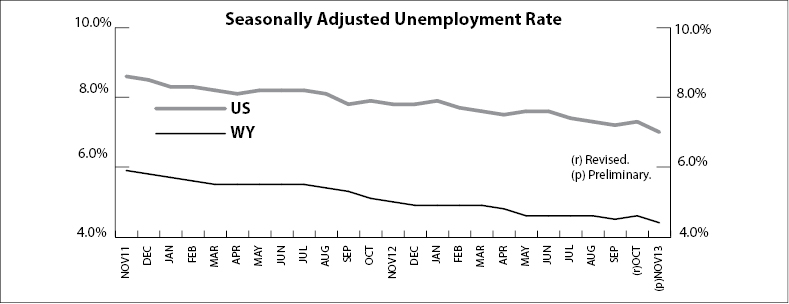Wyoming Unemployment Rate Falls to 4.4% in November 2013
The Research & Planning section of the Wyoming Department of Workforce Services reported that the state’s seasonally adjusted1 unemployment rate fell from 4.6% in October to 4.4% in November (not a statistically significant change). November’s decrease brought Wyoming’s unemployment rate to its lowest level since January 2009. Unemployment remained below its year-ago level of 5.0% and was significantly lower than the current U.S. unemployment rate of 7.0%. Seasonally adjusted employment of Wyoming residents rose slightly, increasing by 1,135 individuals (0.4%) from October to November.
Most county unemployment rates changed very little from October to November. Teton County was the exception as its unemployment rate rose from 5.4% in October to 8.3% in November. Unemployment usually rises in Teton County each November as the summer tourist season has ended and the ski season has not begun. Seasonal decreases in unemployment were seen in Washakie (down from 4.5% to 4.0%) and Goshen (down from 4.4% to 4.0%) counties, possibly because of sugar beet processing.
Unemployment rates decreased in every county from November 2012 to November 2013. The largest decreases occurred in Lincoln (down from 6.6% to 5.0%), Laramie (down from 5.3% to 4.2%), and Crook (down from 4.8% to 3.7%) counties.
Teton County posted the highest unemployment rate in November (8.3%). It was followed by Fremont (5.1%) and Lincoln (5.0%) counties. Sublette and Converse counties tied for the lowest unemployment rate (3.0%). The next lowest rates were found in Campbell (3.2%), Albany (3.3%), and Sweetwater (3.4%) counties.
Total nonfarm employment (measured by place of work) rose from 288,500 in November 2012 to 290,700 in November 2013, a gain of 2,200 jobs (0.8%).
1Seasonal adjustment is a statistical procedure to remove the impact of normal regularly recurring events (such as weather, major holidays, and the opening and closing of schools) from economic time series to better understand changes in economic conditions from month to month.

